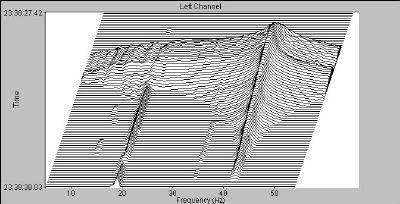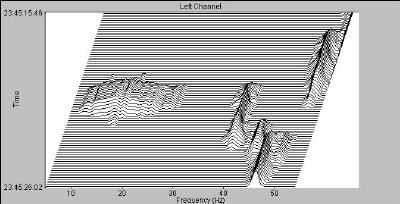John Kotches
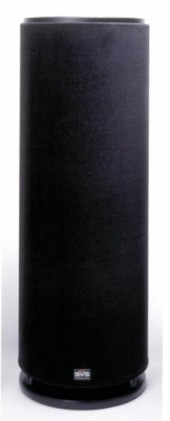
 |
Specifications 16-46CS Driver: 12" Long Throw, Downward
Firing Samson S700 Amplifier Output Power: 250 W/Channel
8 Ohms, 360 W/Channel 4 Ohms 30 Day Price Protection policy 45 Day Return Policy (less return shipping) Package (Dual 16-46CS + Samson amp) MSRP: $1,275 (includes shipping) |
|
SV Subwoofers, Inc., E-Mail [email protected]; Web http://www.svsubwoofers.com/ |
Introduction
Ron Stimpson and Tom Vodhanel are often referred to as the Sub-Humans. It's not meant derisively - these guys are very serious about subwoofers. Ron wrote an article on a DIY Sonotube Subwoofer published by Secrets, and Tom has been a fixture on many an internet discussion forum such as AV Science, Home Theater Forum, Home Theater Talk and Home Theater Spot. How do I know he's a fixture? I spend some time on these forums too! You'll see Tom chiming in on various topics involving subwoofers. In a bit of refreshing honesty, generic questions are answered without a sales pitch - I think Tom realizes that he doesn't have to do a sales pitch - word of mouth and the forthcoming reviews (including this one) will do that for him!
I first ran across Tom prior to the inception of SV Subwoofers, and he was doing bass analysis of various and sundry DVDs to see "who's got the bass". A little post analysis on my part as I sit down writing this review says that Tom and Ron were probably already working on the creation of SV subwoofers when we first crossed paths.
Secrets has been trying to get our hands on their subwoofers for some time, but the realities of a startup business are this: You have to satisfy all the outstanding customer orders first. As much as we reviewers want to get review samples, sending out review gear is expensive. It costs them some unsellable inventory during the review period, and they can't sell the subwoofers as new to the public when they are returned. This is the case for any review sample we receive, but for a startup company it's a much more significant investment than for a larger, more established business.
Due to some fortunate circumstances, like Tom and Ron's on-line voices as the sub-humans, as well some judiciously placed loaner subs to at least one of the above mentioned forums, they were quite busy with a large influx of customer orders and it's taken several months for them to be in a position to send out a pair of subwoofers for me to review.
We discussed my system and what my goals are (frequency extension over maximum SPL) and came to the conclusion that the 16-46CS would be the best solution for my particular system. Then, to make things really interesting, they sent me out the dual CS package with the Samson amp. "Just start with one, then add the second one," they said! So I did.
There are currently three basic models of subwoofers offered by SVS, all of them are named by the tuning frequency of the enclosure followed by the height of the cylinder. In a bit of physics irony, the smallest subwoofer offered has the highest maximum SPL output. That would be the model 25-31, with a 25 Hz tuning frequency (referred to as the F3 point, where the output of the subwoofer is -3 dB vs. a reference level). Next up the line is the model 20-39, with a 20 Hz tuning frequency, and finally the 16-46. You can opt to order these subwoofers as passive devices, where they will have the CS suffix added, to indicate it is a cylindrical subwoofer, unpowered. Or you can order them with a 190 watt amplifier built into the enclosure - these will have the PC suffix appended, which indicates the subwoofer is a powered cylinder. Which subwoofer is right for you is something you have to determine for yourself - if you're not sure, just e-mail Ron or Tom, and they'll get you pointed in the right direction.
On the Quality of Bass That I Like to Hear
One of the things that isn't often discussed is what our personal biases and preferences are as a reviewer. Part of your making an assessment of my conclusions is to know what it is that trips my sonic trigger, and what sound I'm used to hearing.
My system uses full range Electrostatic Loudspeakers (ESLs) for the mains, which are capable of bass reproduction down to 35 Hz or so. For the majority of music I listen to, this suits me fine. I listen to a large amount of acoustic jazz, and popular music with a smattering of classical music thrown in to taste. It's an atypical recording that contains substantial bass below 35 Hz in these styles of music, so for the most part, I'm not really missing much for bass reproduction with these speakers.
It's the quality of the bass that is different
from a dynamic bass speaker. My ESLs will never be able to deliver
the physical impact, but what I do get is taut and very clear
from a timbral perspective. Another interesting aspect of dipole
bass reproduction is the way they can energize a room - this
isn't the same as a dynamic speaker where you feel the impact,
but rather more like the room is awash with the bass frequencies.
I can't explain the physics of this to you yet, but I'm working
on it.
I've made a conscious decision to have speakers with these characteristics
because I'm very sensitive to the pitch and tonal aspects of
music reproduction, and frankly my mains trip my sonic trigger.
Please keep this information in mind as you move forward through
the review.
Bubble, Bubble, Toil and Trouble
Unpacking these beasts from their shipping coffin, err . . . carton, was an interesting exercise. I get the feeling a sarcophogus from Egypt gets packaged less carefully than these subs. The outer carton contained a bubble wrapped inner carton which contained the bubble wrapped subwoofer. Short of throwing them off the delivery truck from a substantial height, I don't see how one of these subwoofers could get damaged in transit. This was the first sign that these guys are serious about their product. Included in the package are four spikes for the subwoofer as well as the operations manual. [Note: There are reports that an SV Subwoofer or two has actually been damaged in transit - further proof that the delivery services can destroy just about any given package.]
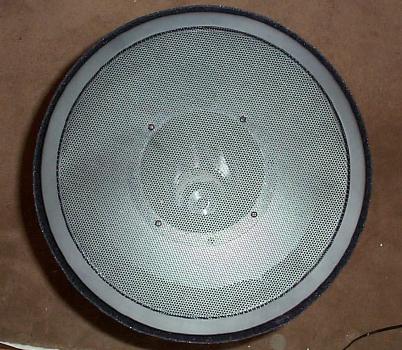
The enclosure includes a 12" long throw downward firing woofer and is capped off with a grille covering the flared port. It towers an impressive 46" above my carpeted home theater room floor. The grille cover is not easily removable, so you have to remove the outer ring, and unscrew the four bolts holding down the grille just to get a look at the custom cut flared port. Then again, this end shouldn't need opening during the lifetime of the subwoofer.
The sides of the subwoofer are covered with an interesting textured black cloth that reminds me somewhat of a velvet canvas upon which is usually painted an image of Elvis Presley. Our cat eyed the sides of this subwoofer as I was unpacking it, and I could hear him thinking, "I have the world's most awesome scratching post, and it's mine, all mine!!!!". In all the time I had these subwoofers in for review, he never actually scratched them, but I swear I heard him thinking about it on more than one occasion.
The single adornment to the outside of the enclosure is a
logo which can be easily hidden by rotating the subwoofer. Other than that
it's a uniform cloth-covered enclosure that hides pretty well in a darkened
HT. With the diameter and height, this will never be a stealth product.
You could think of their initial line of subwoofers
as the Model Ts of the subwoofer market - you can get them in
any color you want as long as it's black!
On the positive side, you aren't spending any dollars of your
subwoofer budget towards a cabinetry grade wood finish, which
can add tremendously to a speaker's price.
Below is a photo of the foot of the subwoofer, which includes the
binding posts for speaker wires. The clearance between the pedestal
and the binding posts is very tight, and conventional banana plugs
(my connector of choice) will not fit into these posts. I imagine something along the lines of
a WBT angled banana plug might work in this space, but I don't
have any on hand to try. Over the years, I've picked up a spare
part or two and managed to locate some unused screw down spade
lugs which ultimately did the job in admirable fashion.
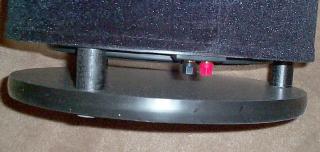
I was somewhat surprised that the manual didn't include more explicit installation instructions, and without my considerable expertise, I might not have been able to screw in the speaker spikes to the base-plate. Of course, all human males are genetically endowed with speaker-connecting abilities, so maybe it is no big deal. That's the extent of assembly of the subwoofer. (For the humor-impaired, this is irony!)
Connecting up the amplifier to your system is yet another exercise in simplicity. The amplifier comes with a Tip Ring Sleeve adapter to go into the amplifier's TRS jack. This adapter will accept an RCA cable from your system's preamp/processor or receiver. If you have a balanced subwoofer output on your receiver, processor, or external crossover (via XLR connector), this can also feed the amplifier. The stereo amplifier can be run as a conventional stereo amplifier, bridged into a single high output channel, or the channels can be run paralleled with a single input. For my review, a single subwoofer was driven by a single, unbridged channel, and dual subwoofer listening tests were run using parallel input mode with discrete channels used for each subwoofer.
Bass reproduction boils down to physics and choices. You can build a small enclosure with large excursion drivers. This type of enclosure requires massive power, and probably some serious equalization - and such subwoofers come with incredibly high output power amplifiers. More commonly you can build a sealed, ported, or transmission line enclosure. The point is, you have to pick your design carefully. If you've read Ron's DIY article cited above, or noticed from the product pictures, you've learned they're a fan of the cylindrical enclosure. The reason for going cylindrical versus the more conventional box is simple. Bracing the enclosure is mandatory in a subwoofer in a conventional box. Because the interior force is exerted uniformly in a cylinder (it has no corners) the enclosure does not need to be rigidly braced in order to have the requisite strength and freedom from resonance. The SV Subwoofer enclosures are not petite, and all share a common diameter of 16.5" - the 16-46CSs I received are 46" high. The good news with this design, is that the enclosure volume takes up a smaller physical space by "going vertical". Another positive for us reviewers is that we don't have to move a 100 pound subwoofer around the room in search of the best bass reproduction!
There are a few small things I think might improve my satisfaction with these subwoofer- the spikes are a bit short for me to feel as though they're penetrating the carpeting to couple to the floor beneath, and as mentioned above, conventional banana plugs won't fit into the binding posts.
And Then There Was One
I started off with a single 16-46CS in the room, and played both movies and music. It was quickly apparent that my own subwoofer was dropping off in my room under 25 Hz rapidly. I am happy to report that the SV does no such thing. So how much content is there below 25 Hz on typical material? For the most part, not much - but I did manage to dig up a little bit.
Tom Vodhanel was kind enough to do some waterfall plots on a CD-R I made for him to give me an idea what I was hearing. Some of it is pipe organ, and some is on pop recordings. This isn't the only material I used, but I can show you a couple of the cuts he analyzed. Tom does this on a regular basis and this was an invaluable tool for me! All of these are part of my "gold standard" discs, i.e., I listen to them on every piece of gear I review.
These waterfall plots are great for showing you what's on a particular recording, but what the heck is a waterfall plot, if you've never seen one? The three axes contain elapsed time on the Y (vertical) axis, frequency on the X (horizontal) axis, and amplitude of that frequency (a.k.a. volume) on the Z (height) axis . The higher a point is, the greater the amplitude (volume) of that frequency. In regions where the plot is flat, there is no frequency content. As greater and greater content for a particular frequency exists for each trace, the lines appear to vary from straight at a given frequency point. This occurs because we're trying to represent 3D data within a 2D space, so the lines look distorted.
In the annotated version below I have labeled the various components of the graph. This is a 10 second snapshot from 2:20 to 2:30 of Sarah McLachlan's Adia off of the disc "Surfacing". In the rectangular box you see that the area from the far left of the graph (about 5 Hz) to roughly 25 Hz is flat, indicating no content. The peaks throughout the 30 Hz - 50 Hz are quite normal, since the cut under analysis contains a synthesized bass and piano. For quick reference, assuming a tuning standard of A4 = 440 Hz, the bottom note on a piano is 27.5 Hz. Doubling the frequency of a note raises the sound one octave on the same tone. So the "A" series from bottom to top has fundamentals of 27.5 Hz, 55 Hz, 110 Hz, 220 Hz, 440 Hz, 880 Hz, 1760 Hz and 3520 Hz.
So now that you know what's going on, let's take a look at some content. You can click on the graphs below to see larger, more detailed versions.
This is Lyle Lovett's She's Already Made Up Her Mind off of the DTS encoded disc "Joshua Judges Ruth", running from about 0:50 to 0:58 seconds into the track. A very large room-filling 40ish Hz and some nice action just under 20 Hz. This shakes my room just a little bit :-)
With my reference subwoofer, I couldn't really feel the sub-20 Hz tone, but with the single SV it was a different ballgame. I could definitely feel the tone from just the single sub.
Here's one from Sarah McLachlan's Angel off of the excellent album "Surfacing". As you can see here, lots of typical electric bass energy in the 40 Hz - 50 Hz range, but also some other information centered in the 16 Hz region. This snippet is from 2:15 to 2:25 into the track. We're not sure what this is to be frank! But I do feel it just a little bit with the SV, and even at louder volumes I don't with my reference subwoofer.
Then we come to the serious bass requirements - it's tough to beat a pipe organ for material down below 20 Hz. These are two waterfall plots from a Chandos Recording with a substantial title . . . "The Grainger Collection Volume 8, Works for Wind Orchestra Volume 2". This is of all things, The Irish Tune from County Derry (yes, Danny Boy). The arrangement is unique, with Grainger painting a much darker tone than is typical. They threw in a pipe organ on this track for good measure, and below are two plots starting on the left at about 3:50 and on the right, at about 5:30 into the track.
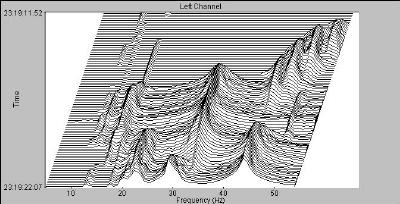 |
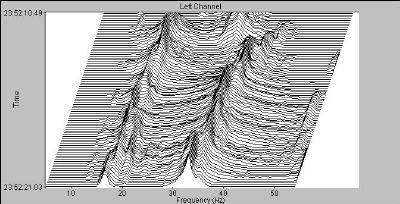 |
Holy far left pedals Batman, this track will make most subwoofers scream for mercy! My reference subwoofer didn't quite make it to this point, and it certainly wasn't capable of the clean, deep output the SV managed. You're probably thinking ridiculously loud volumes, right? Nope - I'm talking 85 dB or so, measured at my seat. With the inaccuracy of the Radio Shack SPL meter at lower frequencies, it's more like 91 dB - 93 dB. As the frequency gets lower, you need more power to maintain a particular dB level. One SV subwoofer managed to fill the room decently at the volume levels I listen.
You know my preference for the tautness
and tonal accuracy based on my earlier information. So as good
as these subwoofers are, it was difficult for me to get the sound
just right for my tastes. I started off by using the stock crossover
in my processor, at the THX specified 80 Hz. This turned out not
to work well for stereo music, as the tonal discontinuity covered
too broad a frequency range for my tastes. I kept on backing
down the crossover until I reached the point where I was finally
satisfied, and this turned out to be 40 Hz. At that frequency, the
subwoofer gives a modest reinforcement of the 40 Hz - 80 Hz octave
(it'll be -24 dB@ 80 Hz ) and starts filling in as my ESLs start
dropping off at 35 or so Hz. This is somewhat counter to the
accepted wisdom (2x the -3 dB point for your mains), but I found
it gave my ears the best results.
So why did that frequency give me the best results? For a 4 stringed
Electric Bass or an Acoustic Bass, the bottom note is 41 Hz -
this is also the last E on the piano keyboard - which
means you have very little material being reinforced with the
subwoofer. I know the subwoofer was doing some fill because the Samson
amplifier has output level indicator
lights, and I'd seem them occasionally flashing as the material
warranted.
Once I got the crossover to my liking, all was bliss for my stereo
listening - I didn't lose the warmth of the acoustic bass, and
the impact of kick drums was a welcome addition to my normal
listening experience. This is not to say the blend was perfect,
but just that I could live with the tonal quality with the crossover
set this low.
With all I've written so far, you might
be curious why in the world SV shipped me two of their subwoofers.
As I alluded to earlier, each halving of frequency requires much
more power to get to the same SPL output. So, if I wanted to truly
approach reference level reproduction in my room, given my choice
of the 16-46, I needed two of them. The downside of this is that
they're big and imposing. The current geometry of my room and
my choice of loudspeakers limit my locations to less than ideal
for the time being - sometime in 2002 I think I'm doing a remodeling
which will get me a better geometry to work with. So I put them
in two varying locations. One was on the right side of my room,
about 2/5 of the way down the side wall. The second was about
1/3 of the way down the back wall of the room. Good news, this
means the subwoofers can be driven off of a single output, they
end up 6' and 5.5' respectively from my primary listening position.
The 6 inches equates to about 0.5% phase error or < 2 degrees.
I can live with that minimal amount of error.
I did some music listening, and even calibrated,
it was obvious that this was going to be overkill for music.
No problem to just unplug one of the sets of speaker cables and
go on about my merry way!
It's when I started putting in the movies with some thunderous
bass that things started getting really interesting . . . the
difference in soundtrack reproduction with thunderous bass is
nothing short of astonishing - our Editor-in-Chief, John Johnson, Jr (aka JJ) is a fan of bass shakers. Me, I haven't played with
them. The nice thing about bass shakers under your chair is that you don't have
to get the whole room shaking to get the visceral impact that
is in some of our current action and Sci-Fi flicks. [Note from Editor: The
reason I use multiple subwoofers is that they can all just be barely turned
on, which gives room shaking bass but almost zero distortion.]
For movies, I'm not quite as rabid about the sound, which isn't
to say I don't appreciate it, but rather that I could live with
the discontinuity that the THX specified crossover of 80 Hz brings
to my system.
I knew it was a whole new baseball game when the Iron Giant
sat down - I felt him in Scene 8 for the first time.
I replayed this scene a few times, and I never once heard the
subwoofer bottom out. For kicks and grins, I warned the neighbors,
got out the earplugs, and turned the volume up. I measured
the loudest peak I've ever had in my room - 107dB. Very impressive
indeed.
We all remember the final battle scene from "Saving Private Ryan"
I suspect - and with ear plugs in, I was peaking at 109 dB at
my listening position. At this point, my entire home theater
room was rumbling as the tank approached. Who needs floor shakers,
when you have room shakers? My reference subwoofer was never
quite capable of delivering this level of bass reproduction without
a sense of strain and an immediate reach for the remote control
to mute and turn the volume down.
So then, what did the 2nd subwoofer buy me?. In all honesty,
nothing for stereo and as close to reference levels as I'm ever
likely going to need for home theater. The SV Subwoofers
provide musically accurate bass and plenty of it for you, and
maybe your neighbors!
The Effect of the Room
The biggest factor in our home
theaters is the room itself. Since very few real HT rooms are
perfect, there are bound to be peaks at certain frequencies
and nulls at others. I started off using a bass decade (10 tones
from 200 Hz - 20 Hz, which covers the main speakers and the subwoofer. Using just the bass decade, my system showed
� 3 dB response,
which is pretty good, but still
the bass was a bit "flabby" and bloated. My Preamp/Processor (B&K Reference 30) has the ability to tame out
the worst
room node, and can test by emitting tones in 2 dB increments
from 20 Hz - 300 Hz. When running this, I found that there's a 6 dB
resonance (peak) centered on 56 Hz, which is conveniently located between
two frequencies (63 Hz and 50 Hz) on the bass decade. There's another
one at 38 Hz that I chose not to touch. Without
the B&Ks capability to test/adjust a room node, I would
have given an inaccurate review of these
subwoofers. See the table below for the measured values. Also, I've matched up
the frequencies as best I could - if you see a frequency in parentheses, this value is for the Bass Decade.
| Frequency | Bass Decade | Pre/Pro Tone | Frequency | Bass Decade | Pre/Pro Tone | Frequency | Bass Decade | Pre/Pro Tone |
| 80 | 75 | 79 | ||||||
| 78 | 81 | 58 | 91 | 38 | 96 | |||
| 76 | 82 | 56 | 92 | 36 | 94 | |||
| 74 | 84 | 54 | 92 | 34 | 94 | |||
| 72 | 86 | 52 | 92 | 32(31.5) | 78 | 90 | ||
| 70 | 87 | 50 | 79 | 91 | 30 | 91 | ||
| 68 | 87 | 48 | 86 | 28 | 89 | |||
| 66 | 87 | 46 | 88 | 26 (25) | 76 | 90 | ||
| 64 (63) | 80 | 87 | 44 | 92 | 24 | 90 | ||
| 62 | 89 | 42 | 93 | 22 | 90 | |||
| 60 | 90 | 40 | 79 | 95 | 20 | 78 | 95 |
Conclusion
SV Subwoofers, with their inaugural series of products, is bringing
in a serious amount of subwoofer performance for a relatively
modest buck! These are very good subwoofers, able to integrate
well with a top notch music system for a discriminating listener,
provided you're patient and find the right crossover frequency
as I did. With movies, they deliver reference level, reference
quality bass as low as 16 Hz for a ridiculously low price.
SV is working on some newer, more costly designs, but their business
is being built with these no nonsense workhorses that are well
within the reach of average enthusiasts. That they can satisfy
even the particular like me is icing on the cake.
I wish them success as they attempt to build their business and look forward
to hearing their more costly efforts down the road.
I'm really beginning to love the way the Internet is allowing companies like SV Subwoofers (and others) to compete with other manufacturers and allowing us consumers to reap the cost benefits of the direct marketing model.
- John Kotches -
© Copyright 2001 Secrets of Home Theater & High Fidelity
Return to Table of Contents for this Issue.

